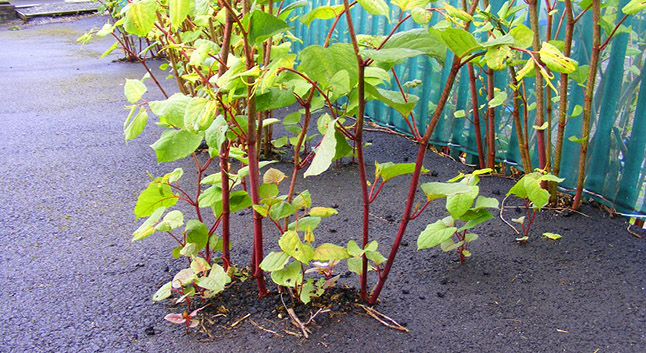Japanese Knotweed is a fast-growing plant. It is covered in white flowers from July to November, propagating itself all summer long. It produces edible, asparagus like shoots and forms large, bamboo like stems that grow up to 7 feet tall in one season... what's not to like ?
Well... Japanese Knotweed is an invasive plant, listed by the World Conservation Union as one of the world's most invasive species. It was introduced to Ireland from Japan in the 19th century as an ornamental plant. But it has since spread across the island of Ireland causing huge destruction. It has spread from north to south and from east to west particularly along watercourses, transport routes and waste grounds, where its movement is unrestricted. Japanese Knotweed causes huge destruction, particularly on development sites, roadways, patios and gravel paths.
How To Identify Japanese Knotweed:
- It has hollow stems with distinct raised nodes that give it the appearance of bamboo.
- Its stems reach a maximum height of 10 - 13 ft.
- Smaller plants are often seen in places where they sprout through cracks in the pavement or driveway.
- The leaves are a broad oval shape with a truncated base.
- It is covered in white flowers from June to November.


What Conditions Does Japanese Knotweed Need To Grow?
Japanese Knotweed will grow absolutely anywhere, growing just as well in poor soil as it will in good soil. It is a dense, strong plant, obliterating anything that attempts to grow beneath it. It is a tenacious plant. If spread, one tiny piece of Japanese Knotweed will grow into a new plant. It needs very little to grow and survive. Although the plant rarely seeds. It is spread by people, machinery and water.
What Problems Can Japanese Knotweed Cause?
- The invasive root system and strong growth can damage concrete foundations, buildings, flood defences, roads, paving, walls and architectural sites.
- It can significantly reduce the value of land, building and development property.
- It is strong enough to damage asphalt and even concrete.


What Should I Do If I See Japanese Knotweed?
If you see this plant growing on your property, in a local area or along a road please report its location to your local county council. Do not remove any piece of the roots, stems or leaves as this will cause it to spread.
Japanese Knotweed has a large underground network of roots, known as rhizomes. To eradicate the plant, the roots need to be killed with a systemic weedkiller (such as Weedfree 360 or SBK). A systemic weedkiller will travel through the plant and into the root system. All above-ground portions of the plant need to be controlled repeatedly, for several years in order to weaken and kill the entire patch. The plant is resilient to cutting, so digging it up or even burning the stump or branches has no effect in controlling this invasive weed.
If you require additional advice on handling this plant contact Horkans for additional advice.

